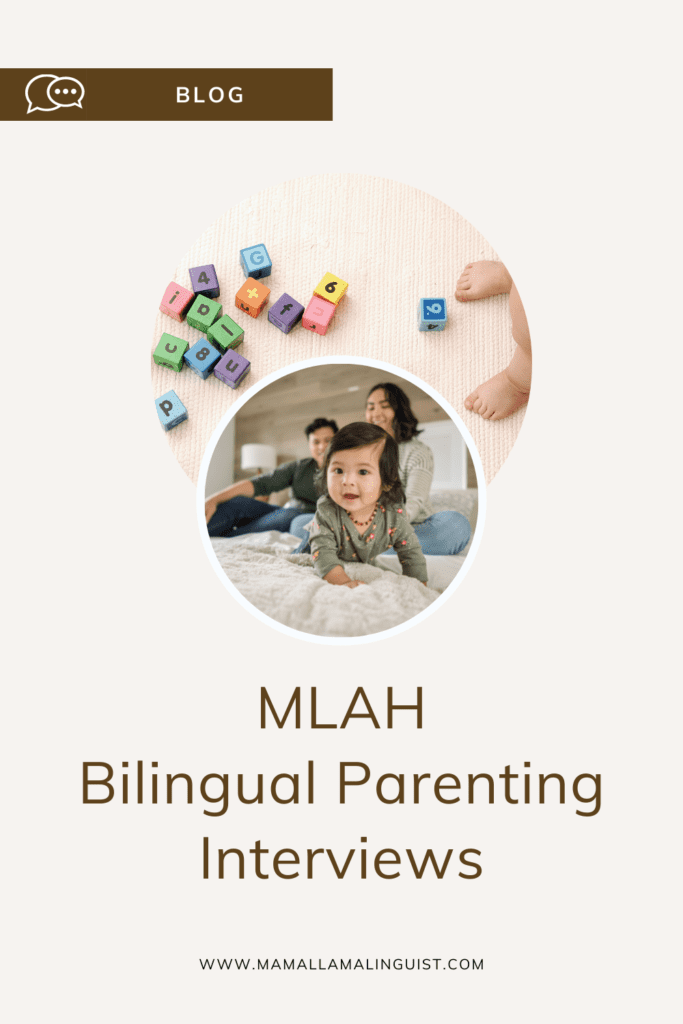
Table of Contents
What is the Minority Language at Home Method?
The Minority Language at Home approach is when parents speak a different language at home then the majority language that is spoken in their community, often in an attempt to maintain a sense of cultural heritage and increase minority language exposure.MLAH Family Interviews
In an attempt to help you decide whether MLAH is a good fit for your family’s dynamic, I interviewed two parents and fellow bilingual Content Creators in my niche that have been living the Minority Language at home. They shared their experiences as well as the pros and cons. I want to highlight here that both Lorena and April confirmed that English is their first language and the one they feel most comfortable speaking. This is so inspiring as I always assumed MLAH parents were native speakers. Let’s dive into the interview!What languages does your family speak?
Lorena: In our bilingual household, up until recently, we used the Minority Language at Home approach, speaking only Spanish at home. My partner, Carlos, is a first-generation immigrant from El Salvador. I have been a forever student of Spanish since my freshman year of high school. I then went on to get my BA and MA in Spanish translation and Latin American studies with minors in Portuguese and Italian. My son, Lennox, is four and can now comfortably communicate in Spanish and English. We have recently switched gears to use the Mixed Language Strategy in our household. The Mixed Language Strategy allows me to speak my native language, English one on one with Lennox. This comes more naturally. As he grows, it gets more difficult to speak my second language to him. As a family, we speak a mixture of Spanish and English, often code-switching or speaking Spanglish. With his papi, Lennox speaks Spanish. April: I was born and raised in the States. I grew up speaking Mandarin at home and then learned English when I went to school. Growing up, I also studied Mandarin at Chinese School on the weekends. In sixth grade, my family moved to Taiwan for a year and I attended a local school there. I studied Spanish in middle school and high school. In college, I studied Chinese and Japanese. During my junior year in college, I studied abroad in Kyoto for a few months as well. My husband was born in Taiwan but grew up in Malaysia. He came to the States when he was in elementary school. My husband grew up speaking Mandarin both at home and at school. When he moved to the States in fourth grade, he learned English. He’s an avid reader, so that is how he was able to maintain his Mandarin despite coming to the States at a young age. My husband and I speak to our daughter in Mandarin (MLAH) but to each other in English. l also try to find time to read books to her in Spanish (Time & Place).
What is your motivation for raising bilinguals?
Lorena: My biggest motivation is to give Lennox the gift of multilingualism from the start. I also want him to have a diverse, multicultural view of the world. Learning languages opened my world in more ways than I can even begin to explain. April: I aspire to raise a daughter who has an open heart and mind toward other people and cultures. I want her to be able to see things from multiple perspectives and respect the differences in people. Most importantly, we want her to feel connected to her heritage and fearlessly embrace who she is despite what the external world may say. Related Post: Best Bilingual Parenting PodcastsWhat are the benefits of Minority Language at Home?
Lorena: Using the MLAH approach for four years has had numerous benefits. For starters, Lennox received a solid foundation in Spanish. He was exposed not only to the Spanish language but his Salvadoran roots as well. MLAH allowed us to emphasize the importance of languages in our home. Even now that we have switched to Mixed Languages, Lennox still leans towards Spanish, even though he hears English a lot more nowadays. It also allowed us to communicate in the same language as a family. As the nonnative minority language parent using MLAH, I have grown tremendously as well. I learned a whole new Spanish that I never learned in school. I learned onomatopoeias, nursery rhymes, how to babble in Spanish, and much more! It was exciting to learn alongside my child. April: The MLAH approach has helped us stay consistent in using Mandarin with our daughter. We also had a win recently – she said her first word in Mandarin! It is not an easy word – 袋鼠 (kangaroo)!! Related Post: 5 Common Challenges of Raising Bilingual Kids
Related Post: 5 Common Challenges of Raising Bilingual Kids
What are the challenges of MLAH?
Lorena: We have faced many challenges using the MLAH approach. For starters, as I mentioned earlier, talking to a baby and toddler in my nonnative language did not come super easy for me. I became more comfortable with time, but once Lennox started asking all of the whys, whats, whens, and how much, I knew it was time to switch to Mixed Languages. This way, I could explain things to him naturally in a way that I knew he would understand. Another challenge was a language delay. By age three, Lennox was hardly talking. Related Post: Speech and Language Delay in Bilingual Toddlers I worried initially, but once I did some research, I learned that this is normal for bilingual children. It is called the silent period. They are taking in two languages and two vocabularies and categorizing each one. Suddenly, one day the languages will click. For Lennox, this happened around when he was three years old. One day, he spoke one to two-word sentences to five to six work sentences in both English and Spanish the next day! It was incredible to witness. Outside opinions were another challenge. For example, my monolingual, English-speaking family was not super thrilled that they could not communicate with Lennox. However, over time they saw that he could understand and communicate in his own, unique way with them through his actions. Lastly, the rest of society constantly reminded me that I would confuse my son and that he needed to learn English at some point. I had to learn to let these comments go in one ear and out the other. I had done my research, and I knew what was best, so I would just have to let the outsiders have their opinions and show them otherwise. April: Since both my husband and I are stronger in English, we catch ourselves occasionally speaking English to our daughter. Sometimes we will alternate between Mandarin and English within a conversation as well (code-switching). Although I code-switch quite often in daily life, I do want to be aware of how often I do it in front of my daughter. I want to make sure I am a good language model for her, so she develops the ability to converse in one language when needed. Since returning to work from maternity leave, it’s been challenging trying to find time to consistently read to my daughter in Spanish!
Final tips for parents raising bilingual children?
Lorena: 1. Exposure, exposure, exposure. Find as much input in the minority language as possible and roll with it. If you are a non-native parent like myself, let raising your child bilingually be a learning process for you too! Family learning is fun, especially when the end result is bilingualism! 2. Play. I am all about printables and worksheets, but there is no better way to learn a language than through play! Keeping play in the minority language will increase the need for the child to speak the language and will make language enjoyable! 3. Don’t be too hard on yourself. I have suffered from horrible guilt over the years. Guilt that Lennox wasn’t learning any language properly. Guilt if I spoke in English to him. Guilt if I didn’t play enough. Guilt if I didn’t read a book that day. Guilt, guilt, guilt. Parenting in itself is challenging. Just remember that you are doing a selfless act for your child by raising them bilingually. Do not aim for perfection, and do not burn yourself out. Just parent as naturally as possible and include the minority language as much as you physically and emotionally can. If you can’t do it one day, then that’s okay. There are more days. Your health and family connection should come first. April: 1. Be Consistent – Consistency is key! Children need constant exposure to become bilingual. They need to see, hear, and speak the language consistently. 2. Be Realistic – Recognize your family’s strengths and limitations when setting a goal for raising bilingual children. Sometimes we may have ambitious dreams which can overwhelm us when it’s beyond what we can manage. 3. Give Yourself Grace – It’s tough enough raising children, let alone bilingual or even multilingual children! Know that at the end of the day if we have tried our best, that is good enough! Let’s not beat ourselves up over regrets. A lot of times, timing is a key ingredient as well. If the timing is not right, we may try with all our might to no avail.Connect with Lorena and April
Lorena is the founder of the blog Bilingual Beginnings (www.lorenaylennox.com) where she shares bilingual parenting tips and Spanish resources for the early years. She is a mom to a 4 year old boy who she is raising bilingual in English and Spanish. You can connect with her on Instagram and Facebook. April is the founder of Seedlingo (www.seedlingo.co) which is soon to be launched. She is a Mandarin dual-immersion teacher and a new mom to a little girl. Connect with her on Instagram.
Concluding thoughts on Minority Language at Home
Ultimately, choosing a Family Language Policy can be a life changing decision. No doubt, Minority Language at Home is a powerful, and arguably the most immersive, strategy. If you are a native speaker, or, like Lorena and April, you feel confident in your minority language, then this could be a really great option! However, please don’t feel you have to turn to MLAH to be successful in raising truly bilingual kids. My family uses the Time & Place approach and we outsource a lot of Spanish input and exposure with Dual Language Immersion schools. Related: Listen to my interview on The Bilingual Parenting Podcast about Time & Place. You have to be comfortable with how this dynamic will effect the whole family. My family chose not to embrace the MLAH method because my husband is at a beginner’s Spanish level and therefore wouldn’t have been able to communicate or bond fully with his children. As obsessed and passionate I am with Spanish, my husband’s bond with his children takes priority. If you are not comfortable in your own level of Spanish (or the minority language) then continue to improve that with Spanish resources for adults. This could be Spanish podcasts, courses, movies, books and even intercambios. Then outsource your child’s learning with native speaker classes or immersion programs in your area. You can also take advantage of screen time by using Spanish Learning Apps. As Lorena and April highlighted, consistency and exposure are key to successful language acquisition.Related posts:
If you enjoyed this round-up, you may also enjoy these resources:
Best Bilingual Parenting Podcasts

